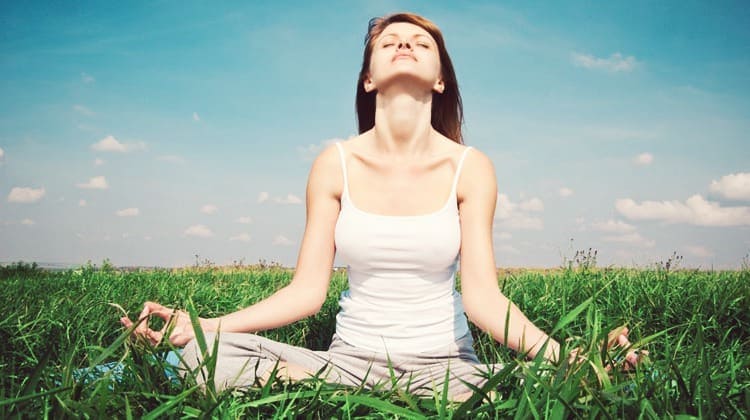Incorporating Breathing Meditation Into Your Daily Routine

Are you feeling overwhelmed and stressed in your daily life? Incorporating breathing meditation into your routine can be a powerful tool to find calm and inner peace.
In this article, we will explore the benefits of breathing meditation and how you can easily integrate it into your daily activities. Discover how this simple practice can help you manage stress, enhance mindfulness, and improve your overall well-being.
Take a deep breath and let’s dive in!
Key Takeaways
- Start the day with a sense of calm and focus
- Set a specific time and create a dedicated space for meditation
- Use techniques for deep breathing, such as diaphragmatic breathing or alternate nostril breathing
- Tips for consistency: start with shorter sessions and gradually increase duration
Benefits of Breathing Meditation
One of the benefits of breathing meditation is that it helps to reduce stress and anxiety.
When you practice breathing meditation for sleep, you can experience a sense of calm and relaxation that prepares your mind and body for a restful night.
By focusing on your breath, you can let go of the worries and thoughts that keep you awake, allowing yourself to drift into a peaceful slumber.
Additionally, breathing meditation for focus can help improve your concentration and productivity.
By bringing your attention to your breath, you can train your mind to stay present and avoid distractions.
This can be particularly helpful when you need to study, work on a project, or complete tasks that require sustained attention.
Incorporating breathing meditation into your daily routine can have profound effects on your overall well-being and mental clarity.
Understanding the Basics of Breathing Meditation
To grasp the fundamentals of this practice, you should begin by understanding how focusing on your breath can bring about a sense of calm and clarity.
Breathing meditation is a technique that involves paying attention to your breath as a way to anchor your mind in the present moment. By doing so, you can experience a range of benefits, including reduced stress, improved concentration, and increased self-awareness.
Here are three different types of meditation techniques that can be incorporated into your daily routine:
- Mindfulness meditation: This involves focusing on your breath and observing your thoughts and sensations without judgment.
- Loving-kindness meditation: This practice involves cultivating feelings of compassion and kindness towards yourself and others.
- Body scan meditation: This technique involves systematically bringing your attention to different parts of your body, promoting relaxation and body awareness.
Creating a Sacred Space for Meditation
When it comes to creating a sacred space for meditation, there are a few essential elements you should consider.
First, find a quiet and peaceful location where you can retreat to without any distractions.
Next, gather items that bring you a sense of calm and serenity, such as candles, incense, or meaningful objects.
Lastly, don’t be afraid to personalize your meditation space to reflect your unique preferences and personality.
Essential Meditation Space Elements
Create a calming meditation space by incorporating essential elements such as comfortable cushions, soft lighting, and soothing scents.
To create a tranquil environment for your meditation, consider the following essentials:
- Comfortable Cushions: Choose cushions or a meditation mat that provides proper support for your body. This will help you maintain a comfortable and relaxed posture during your practice.
- Soft Lighting: Opt for soft, warm lighting in your meditation space. Avoid harsh overhead lights and instead use candles, string lights, or a Himalayan salt lamp to create a soothing ambiance.
- Soothing Scents: Incorporate aromatherapy into your meditation space by using essential oils or scented candles. Scents like lavender, chamomile, or sandalwood can help promote relaxation and calmness.
Personalizing Your Meditation Space
Adding personal touches to your meditation space can help create a sacred and inviting atmosphere. Personalizing your meditation space is essential for finding tranquility and creating a space that truly reflects your unique energy and preferences.
Start by choosing colors that promote relaxation and calmness, such as soft blues or earthy tones. Decorate the space with items that hold special meaning to you, like a favorite piece of artwork or a cherished memento. Consider incorporating natural elements like plants or crystals to enhance the energy in the room.
Don’t forget to add comfortable cushions or a cozy chair for your meditation practice. By personalizing your meditation space, you create a haven where you can fully immerse yourself in the present moment and find peace within.
Incorporating Breathing Meditation Into Your Morning Routine
When it comes to incorporating breathing meditation into your morning routine, there are several benefits to consider.
Not only does morning meditation help you start your day with a sense of calm and focus, but it also sets a positive tone for the rest of your day.
To deepen your practice, try using techniques for deep breathing, such as diaphragmatic breathing or alternate nostril breathing.
And if you struggle with consistency, here are some tips to help you stay on track: set a specific time for your meditation practice, create a dedicated space for it, and start with shorter sessions before gradually increasing the duration.
Benefits of Morning Meditation
Start your day off right by practicing morning meditation, which can bring numerous benefits to your overall well-being. Taking a few moments each morning to sit in stillness and focus on your breath can have a profound impact on your mental, emotional, and physical health.
Here are three benefits of incorporating morning meditation into your daily routine:
- Reduces stress and anxiety: Morning meditation helps calm your mind and relax your body, reducing the levels of stress hormones in your system and promoting a sense of inner peace.
- Improves concentration and focus: By practicing mindfulness during your morning meditation, you train your brain to stay present and focused. This can enhance your ability to concentrate throughout the day.
- Boosts energy and productivity: Starting your day with meditation can increase your energy levels and improve your overall productivity, as it helps clear out mental clutter and enhances mental clarity.
Techniques for Deep Breathing
One effective technique for deep breathing is to focus on your breath as it naturally expands and contracts in your body. This technique can be used for both relaxation and better focus.
When you focus on your breath, you bring your attention to the present moment, allowing yourself to let go of stress and tension. As you inhale, feel your breath filling your lungs, expanding your chest, and notice the sensation of your abdomen rising. As you exhale, feel the release of tension and let go of any negative thoughts or distractions.
Deep breathing exercises like this can help calm your mind, reduce anxiety, and improve your ability to concentrate. By incorporating these simple techniques into your daily routine, you can experience a greater sense of relaxation and focus throughout your day.
Tips for Consistency
Now that you’ve learned some techniques for deep breathing, let’s talk about tips for consistency in incorporating breathing meditation into your daily routine.
Consistency is key to experiencing the full benefits of this practice and maintaining motivation. Here are some helpful tips:
- Set a specific time: Establish a regular time for your breathing meditation practice. This will help you make it a habit and ensure you have dedicated time for mindfulness.
- Start small: Begin with shorter meditation sessions and gradually increase the duration over time. This will make it easier to integrate into your daily routine and prevent feelings of overwhelm.
- Create a peaceful environment: Find a quiet and comfortable space where you can practice without distractions. This will enhance your focus and make the experience more enjoyable.
Using Breathing Meditation to Manage Stress and Anxiety
If you’re feeling stressed or anxious, incorporating breathing meditation into your daily routine can be incredibly helpful. Breathing meditation is a simple yet powerful technique that can assist you in managing panic attacks and reducing tension headaches.
By focusing on your breath and bringing your attention to the present moment, you can calm your mind and relax your body. When a panic attack strikes, taking slow, deep breaths can help regulate your heart rate and bring a sense of calm.
Additionally, practicing breathing meditation regularly can help reduce the frequency and intensity of tension headaches. As you become more aware of your breath and learn to control it, you release tension and promote relaxation throughout your entire body.
Enhancing Mindfulness Through Breathing Meditation
To enhance your mindfulness, focus on your breath and bring your attention to the present moment. By practicing breathing meditation, you can enhance your focus and promote relaxation. Here are three ways breathing meditation can help you achieve this:
- Deepens your awareness: Paying attention to your breath allows you to become more aware of the present moment. As you focus on each inhalation and exhalation, you become fully engaged in the here and now, leaving behind distractions and worries.
- Calms the mind: As you breathe deeply and rhythmically, your body’s relaxation response is activated. This promotes a sense of calmness and tranquility, helping to alleviate stress and anxiety. Your mind becomes more peaceful and clear.
- Improves concentration: By directing your attention to the breath, you train your mind to stay focused on one thing at a time. This practice strengthens your ability to concentrate, enhancing your productivity and overall performance.
Incorporating breathing meditation into your daily routine can have profound effects on your well-being, enhancing your ability to stay present, focused, and relaxed.
Expanding Your Meditation Practice With Advanced Breathing Techniques
Expand your meditation practice by incorporating advanced breathing techniques. These techniques can deepen your mindfulness and promote a greater sense of relaxation and focus. Advanced breathing techniques go beyond the basic deep breathing techniques commonly used in meditation.
These techniques involve deliberate control over your breath to enhance your meditation experience. One such technique is ‘alternate nostril breathing.’ With this technique, you inhale through one nostril while closing the other with your finger, and then switch nostrils. This technique helps balance the energy in your body and calms the mind.
Another technique is ‘diaphragmatic breathing.’ With this technique, you focus on breathing deeply into your diaphragm, allowing your belly to rise and fall with each breath. This type of breathing activates the parasympathetic nervous system, inducing a state of relaxation.
Frequently Asked Questions
Can Breathing Meditation Help With Physical Health Issues?
Breathing meditation can help with physical health issues. It has been shown to reduce chronic pain and improve immune system function. Try incorporating it into your daily routine for these benefits.
How Long Should I Practice Breathing Meditation Each Day?
You should practice breathing meditation for at least 10-20 minutes each day. This alternative meditation technique has numerous benefits, including stress reduction, improved focus, and increased relaxation through deep breathing.
Can Breathing Meditation Be Done While Lying Down?
Yes, breathing meditation can be done while lying down. It has numerous benefits, such as reducing stress and promoting relaxation. There are different types of meditation techniques that you can explore to find what works best for you.
Is It Necessary to Sit in a Specific Position While Practicing Breathing Meditation?
No, it isn’t necessary to sit in a specific position while practicing breathing meditation. You can choose a comfortable sitting position that allows you to focus on your breath and use different meditation techniques.
Can Breathing Meditation Be Done in a Busy or Noisy Environment?
Yes, breathing meditation can be done in a busy or noisy environment. It can help you find calm and focus amidst the chaos, reducing stress and increasing mindfulness in a fast-paced world.









